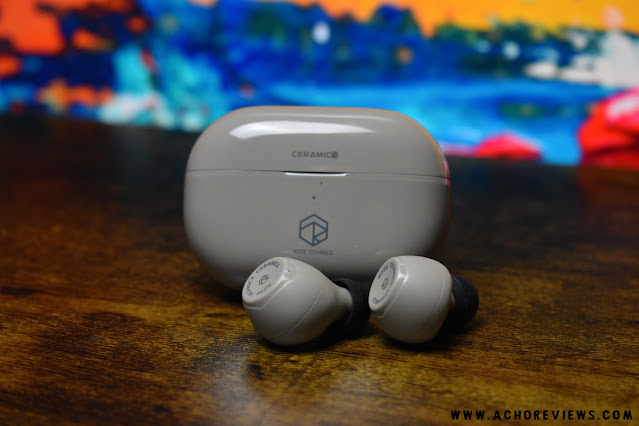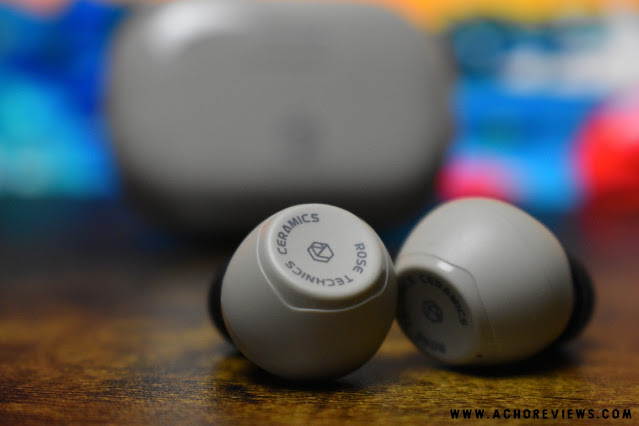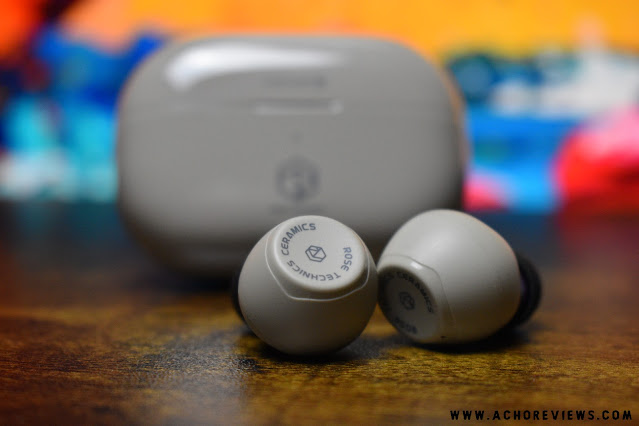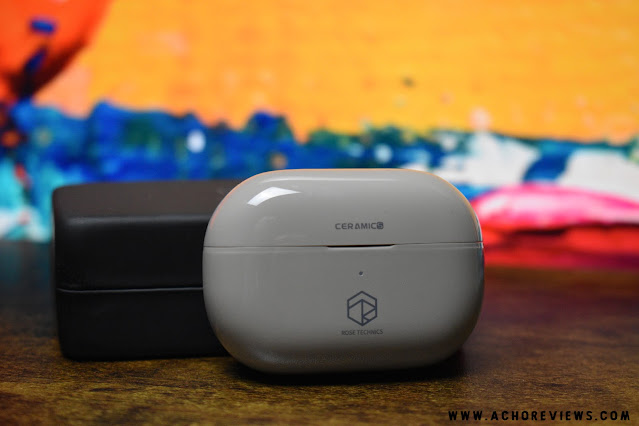- Get link
- X
- Other Apps
English | Español
TLDR version on YouTube: TDLR - Rose Technics Ceramics
The Rose Technics Ceramics have been sent to me by Linsoul in exchange for the publication of my thoughts in this review. Linsoul have not made any requests and I will do my usual best to be as unbiased as possible.
The Ceramics can be found via Linsoul here: https://www.linsoul.com/products/rosetechnics-ceramics
Non-affiliate link, as always.
Intro…
While I have always maintained that I don’t review or spend a lot of time with TWS, lately that seems to not be quite true. You may have seen my recent ramblings (I can’t really call it a review) about the Sony Linkbuds S, where I said that I picked commodity over sound quality, something that is not usual for me personally.
It is true that the sound quality of TWS IEMs is getting better but I am still of the opinion that they have a long way to go before matching the sound quality of many of the cheaper wired alternatives. This is something that I find true at all TWS price points that I have tried, even sets costing around 600€ that sound decent but are no match for other wired alternatives that come in at a third of the cost.
While there are some sets that are using very high quality drivers and some in depth processing to make things a lot better, the truth is that they are still fighting against a very difficult thing to overcome. Size. You need to fit the drivers, the DAC, the amplification, the DSP, the battery, the charging system for the battery, all into a very small space while still managing to leave enough of a cavity for the air that the drivers need to work well.
But really, at least for now, TWS is not about sound quality, it is about the commodities of having something so small and easy to use, without being tied to a device by means of a cable. I am sure that these will continue to advance and at some point we may start to get options that do rival cabled alternatives, but for now, I feel that we are still looking at the best functionality we can get while also getting a “decent enough” sound.
Why am I saying all of this? Well, I want to make it clear that I don’t think it is fair to compare TWS IEMs with wired IEMs, at least not in similar price brackets, therefore it would not be fair if I do a direct comparison of the Ceramics to a set of wired IEMs in the sub 40€ price bracket, which is what the Ceramics sell for at the time of putting together this review (EDIT: They are actually less than 30€ at the time of publishing this review).
My current bench mark for TWS are the Linkbuds S, not because of sound quality but because of functionality and I think that, even though the Ceramics are less than a third of the price of the Sony, the comparison is fairer than putting them up against something like the 7Hz Zero (1 or 2), paired with an Apple dongle, which come in at around the same price (including the Dongle) is not really fair.
So, basically what I am saying is that my reviews of TWS IEMs should be treated as an independent thing. Much like the difference between me reviewing a set of IEMs and a set of over ear headphones.
Anyway, enough with the rambling and on with the review…
Presentation…
The Rose Technics Ceramics arrive in a fairly basic white package that features an image of them on the cover, along with the model, brand and “Hi-Fi True Wireless Stereo Earbuds” underneath. On the back of the box we get some basic specs, line the operation range (15m), Bluetooth version (5.3), charging time (approx. 40 mins) and the impedance (32 Ohms).
It is a little strange to see the impedance mentioned on a set of TWS as it isn’t really relevant due to the fact that they already have all the amplification built in etc, yet there is no mention of the codecs that the Ceramics offer.
Inside the main package we find two smaller white boxes with the Rose Technics logo on them, one labelled as “Earphone Box” and the other as “Accessories”.
Opening the Earphone box reveals a largish black plastic case with the Rose logo on it, which I thought was the actual case of the IEMs and my first thoughts were “this is rather large”. However, opening the black flip top case reveals a much smaller case on the inside which is actually the IEMs storage/charging case. The larger black case is quite nice with a padded interior although I couldn’t help wondering why they decided to pack a case inside a case, inside a box inside a box.
Inside the accessories box we find a USB-A to USB-C charging cable and three sets of silicone tips. In addition to this we get a user manual explaining the functionality (and contents) of the package.
You may be thinking that this is not exactly a lot of content but it is exactly the same content as received with the Linkbuds S at more than three times the price. Well, it’s actually more as we get the extra case to store the case 😉
Build and Aesthetics…
The Ceramics are available in 3 different colours, all black, grey with black internals and white with pink internals. I received the grey set and I think they look pretty good, although they do have sort of a beige tint to the grey, depending on the light.
The storage/charging case is very compact, around the same size as the Linkbuds S case and even a little thinner overall, meaning that they fit easily even in a fifth pocket and will not be something irritating to carry around with you (which is very important to me, as I think one of the positives of TWS is having them always available). This does mean, however, that the internal space of the case is not really very big. I can fit them in the case with Symbio medium sized tips installed but anything larger will mean that they don’t fit in the case properly (they wont fit with Symbio large).
The charging port is located on the bottom of the case, which is something I would usually complain about as you cant charge them standing up, yet in this case (pun intended), it won’t stand up anyway due to the rounded shape of the bottom.
The IEMs (or should I call them buds like everyone else?) are also very compact. They are almost round in shape and sit fairly well inside the ears, although they do stick out a little more than something like the Linkbuds S.
In general I like the size, they seem to be well built and the aesthetics don’t really displease me either.
Functionality…
Pairing for the first time is pretty straight forwards as it is with most TWS. Open the case and take them out, then look for them in your device and pair them. They can also connect to two devices simultaneously, which is a little more complicated (although the manual explains it well) but does work correctly. I could listen to music from one phone and then take calls from the other phone with seamless switching over between devices and back again once ending the call. I know that not everyone uses two phones but it is handy to be able to connect to a tablet or computer while still having a connection to a phone.
As far as I am aware, there is no App for the Ceramics (EDIT: I found out after putting together this review that there is actually an App. However, after trying for more than 30 minutes to connect it to the Ceramics and failing, it's like not having an App). Personally I prefer no App over a buggy and bad performing App but, in this case, I wouldn’t have minded an App to remove some of the functions from the IEMs themselves as there is a lot going on and it can get confusing when you are using different sets of TWS (i.e: different control set ups).
Each side is a touch surface which is not really over sensitive but still suffers from touches when adjusting the IEMs in your ear etc. As you will see now, depending on how many accidental touches you make, you can make quite a few changes.
Volume up - Single tap on right
Volume down - Single tap on left
Previous track - Hold left for two seconds
Next track - Hold right for two seconds
Play / Pause - Double tap on right or left
Answer / End call - Double tap on right or left
Reject call - Hold for 2 seconds either left or right
Voice assistant - Triple tap on right
EQ mode - Triple tap on left
Game mode - Quadruple tap on left or right
As you can see, there is a lot going on and even after reading the manual (which we all know is not my first step 😉 ), I still found myself confused by the control layout.
I appreciate the fact that you can adjust volume from the IEMs, something that I have complained about with other models, but in this case the volume of the Ceramics is independent to the actual phone volume.
The fact that it is a single tap and there are many other functions with multiple taps can make it a little more complicated, yet the steps are pretty large. As I listen to all kinds of music, a lot of the time on random playback, there are many volume differences between tracks and turning up for a quieter track may lead to overly powerful levels on the next track, in the end, I found I grabbed my phone to change the volume rather than using the onboard controls and volume, which sort of defeats the object.
Also, both the EQ mode and the Game mode are things that I really don’t need to change on the fly, in fact, I don’t really need to change them at all, so these are things that I end up changing by accident and finding myself unsure of what I have done.
There is a voice that informs you of changes made but for some reason, there are two different voices depending on what you have done. It leads me to believe (just making assumptions here) that the control system was taken from a different model and extra things were added to the Ceramics.
There is no real mention of what the gaming mode does, although the Rose Technics web (and Linsoul) does mention that the Ceramics can offer latency as low as 60ms which ensures a “quick response in FPS games”. I honestly don’t know what it changes as far as the internal set up when activated but it doesn’t change frequency response and I don’t game, other that the odd retro session etc., so I can’t say I have improved much in the FPS gaming world 😀
One thing it does mention about it in the manual is under troubleshooting:
"Q: Noise in game mode?
A: Game mode is for gaming only. For other scenarios, please witch back to music mode"
So it obviously does something.
EQ I will mention in a moment under sound, so that just leaves the charging case. This is stated as having fast charge, with 10 minutes offering six hours of uninterrupted playback, but it doesn’t really say anything about the charging of the actual case. As I haven’t actually run it down to zero, I can’t say how long charging of the case takes.
There is a status LED on the front of the case which tells you the level of the battery, the charging state etc. All of this is explained in the included manual.
Finally, as far as Codecs, the options are SBC or AAC yet I found that setting it to SBC in Gaming mode would break the connection and stop them from working. In music mode, both AAC and SBC work fine. There is also something to note and it is the fact that the Ceramics only have 44.1kHz sample rate, meaning that everything will be resampled by them to 44.1kHz.
Sound…
All tracks mentioned are clickable links that allow you to open the reference track in the streaming service of your choice (YouTube, Tidal, Qobuz, Spotify, etc.)
Let’s start off by addressing the EQ modes on the Ceramics. There is no “flat” or “off” setting, so you have to choose between either “Hifi Music Mode”, “Pop Music Mode” or “Rock Music Mode”. Just to repeat that there is no difference between Gaming and Music modes as far as frequency response. The same three EQ settings are available in both modes and the response is the same.
Ok, so here is a graph of the 3 EQ modes (just in Music mode to not show an extra 3 irrelevant lines), with my usual preference curve for reference:
Ok, so where do I start?
Usually I would just tell you which of the EQs I prefer and then go on to explain my opinions with that setting, maybe with a few notes about the other settings along the way. However, I really can’t say that I “prefer” any of them.
So, rather than follow my usual frequency categories, I am going to mention a few of the tracks from my test list, those that I usually refer to the most, and then say how I find that track with each of the 3 EQ settings.
Of course we have to start with “Chameleon” by Trentemoller...
Hifi Mode: There is a noticeable lack of rumble on the Ceramics compared to many other sets. Let’s face it, this track is pretty crazy in the low end, so I can’t really say there is a lack of bass but it doesn’t rumble like it should. There is also a lack of lower mids and mid range in general, with things clearing up a little due to the excessive presence between 2.5 and 5kHz. This makes certain sounds stand out while others seem to be darker and merge together.
Pop Mode: Ok, here we cant say there is a lack of rumble, what we can say is that there is a lack of clarity in the lower ranges of the track. While the drivers don’t seem to be struggling, they also don’t seem to be defining the subbass either. There is, again, a lack of mids in general, with the (even more excessive) upper mids/lower treble giving clarity to some sounds but struggling to do so due to that immense rumble happening at the other extreme.
Rock Mode: Now we are just getting silly :) I know that there are people who will find this quantity of bass great but I am not one of them. The low end rumble just takes over the whole track and even that excessive 2.5 to 5k can’t really break through that wall of rumble. Personally I find this to be nauseous and is literally just rumble with not much else to be appreciated. I am literally grateful to get to the end of my detailed listening with this track and this EQ.
Another track I mention almost as much as “Chameleon” is “Crazy” by Daniella Andrade...
Hifi Mode: In this mode the overpowering reverb in the lower ranges is avoided yet it does give the overall track a focus in those upper mids, making her vocals sound a little thin and harsh. To this we add a treble that is not really smooth and details stand out but do sound a little artificial at times. There is also a slight hint of sibilance on occasions, with the sounds of her mouth (lips etc.) seeming over emphasized at times.
Pop Mode: Here there is even more emphasis placed on those upper mids with sibilance being more noticeable than with HiFi mode. Although there is more present in the lowest ranges, it is mostly below where the guitar reverb resides, so it doesn’t really affect the low end of this track much in comparison.
Rock Mode: This is my preffered option out of the three for this track. There is still a hint of sibilance but the upper mids/lower treble doesn’t come across quite as exaggerated with this EQ. Again the low boost is mostly below the reverb, so there is a slight touch more but not enough for it to become overly present in the midbass, although it doesn’t seem quite as clean.
Something with a bit of electronic subbass but without the excess of “Chameleon” is “No Sanctuary Here”...
Hifi Mode: Here I find that the low ranges of the track are rather dull in comparison to what I would usually expect from this track. There is also a lack of body to the vocals of Chris Jones, leaving the upper mids exposed. This is not as bad as with female vocals, not as harsh, but does lose a lot of the excitement that this song brings.
Pop Mode: Now the excitement of the subbass is back, although I think it is a little overly present for the rest of the track, or at least overly present for the mids, which again lack the body to the vocals, making them take a back seat behind the subbass. The thing I found here is that the vocals are ok while there is a break in the bass but when the bass comes back, it does overshadow them, even with that 3k presence.
Rock Mode: Again I find that the subbass is overpowering when in this mode with this track. It eliminates all sense of clarity and while I still maintain that the driver doesn’t do a bad job, all you are really experiencing is subbass with some other sounds in the background. Not something I would pick personally.
Seeing that we have a “Pop” mode, lets try something I would consider modern pop, “Don’t Start Now”...
Hifi Mode: Here the bass is actually pretty impressive, with nice clean hits, keeping the rythm entertaining yet not overpowering. The issue here is that once more, we are missing some body to the lyrics of Dua Lipa, with the upper mids sounding a little fragile. There is the slightest hint of sibilance at times but nothing that I would complain about. I would actually complain more about certain sounds that suddenly sound harsh when they coincide with one of the upper peaks, such as the pluck of a bass string etc.
Pop Mode: This is what should be selected for this track, no? Well, I have to say that the bass is possibly even more impressive than in HiFi mode, especially if you like a nice amount of it. The bass isn’t bloated and its clean and decisive in it’s rithym. The issue here is that things sound even more fragile in the upper ranges. Sibilance is slightly more present but not terrible, just peaky overall in the upper ranges.
Rock Mode: Ok, if I wanted to impress someone with bass on a set of TWS, then this track with this mode is pretty amazing. It stays clean and defined, with plenty of bass and I find it sounds better than Pop mode to my ears. Here the upper mids are still a little fragile but not as bad as with the other modes, mainly because they hide behind a a lot of bass. I still wouldn’t say it sounds good, the upper ranges are by no means something I would choose but I still admit that the bass on this track is impressive in this mode.
Seeing that we did Pop, I guess we should do something for Rock also, so let’s use a classic, “Whole Lotta Love” by Led Zeppelin ...
Hifi Mode: The thing that stands out to me the most here is the upper ranges of the electric guitar as it hits those higher chords. In general the track is sort of dark and distant but then suddenly those chords cut through like a knife in the left ear. The track is listenable although lacking presence in the mids, until those chords appear and are, let’s say, uncomfortable.
Pop Mode: When the track starts, the bass guitar sounds rather impressive but I wouldn’t say it sounds like it should. As soon as it mixes in with the other instruments and vocals, it then becomes a sort of wall that makes it difficult to actually separate what is going on.
Rock Mode: We saw that Pop mode didn’t really work for Pop, at least the track I selected, so does Rock mode work for this Rock track? Well, not really. Again the bass could be considered impressive at the beginning but it again turns into a confused mix when multiple things are happening. To be honest, this is not exactly a complex track but things just don’t sound right on it, with certain parts seemingly like a wall, while other suddenly cut through and sound like they are from a different recording.
Conclusion…
These are a budget set of IEMs, coming in at 40€ (EDIT: Now less than 30), and I have to say that they try to pack in a lot of things for the price, maybe too many things, and unfortunately sound quality is not one of them, at least in my opinion.
There are 3 EQ modes and the only real difference between them is how much subbass we get and how harsh it is around the 3k to 5kHz mark. I appreciate that not everyone has the same tastes and the fact that they have aimed to cater for 3 different profiles, yet none of them match my personal tastes (which is ok, I understand I am difficult) but they also don’t sound great.
The details are pretty decent, yet the peaky treble makes them sound artificial at times. The upper mids and lower treble are just too present and give things a harsh and fragile sound. The mids are the opposite, lacking in presence and leaving many vocals without any real body to them.
That just leaves the bass. I have to say that the bass is pretty impressive. That doesn’t mean I like it, there is too much of it for my tastes, but I still have to admit that it can be impressively clean and present on certain well mixed tracks. Of course, it didn’t work well with “Chameleon”, due to the track being overpowering and adding the additional overpowering bass of the Ceramics. But still, I can’t deny that these TWS have enough bass for most of the bass lovers out there.
I really can’t say I am a fan of these TWS IEMs and, although I do think that some people will enjoy them just for that excessive bass, I feel that there are other options in this price range that make much more sense.
All FR measurements of IEMs can be viewed and compared on achoreviews.squig.link
All isolation measurements of IEMs can be found on achoreviews.squig.link/isolation
To comment or contact, visit any of the following social media platforms:








